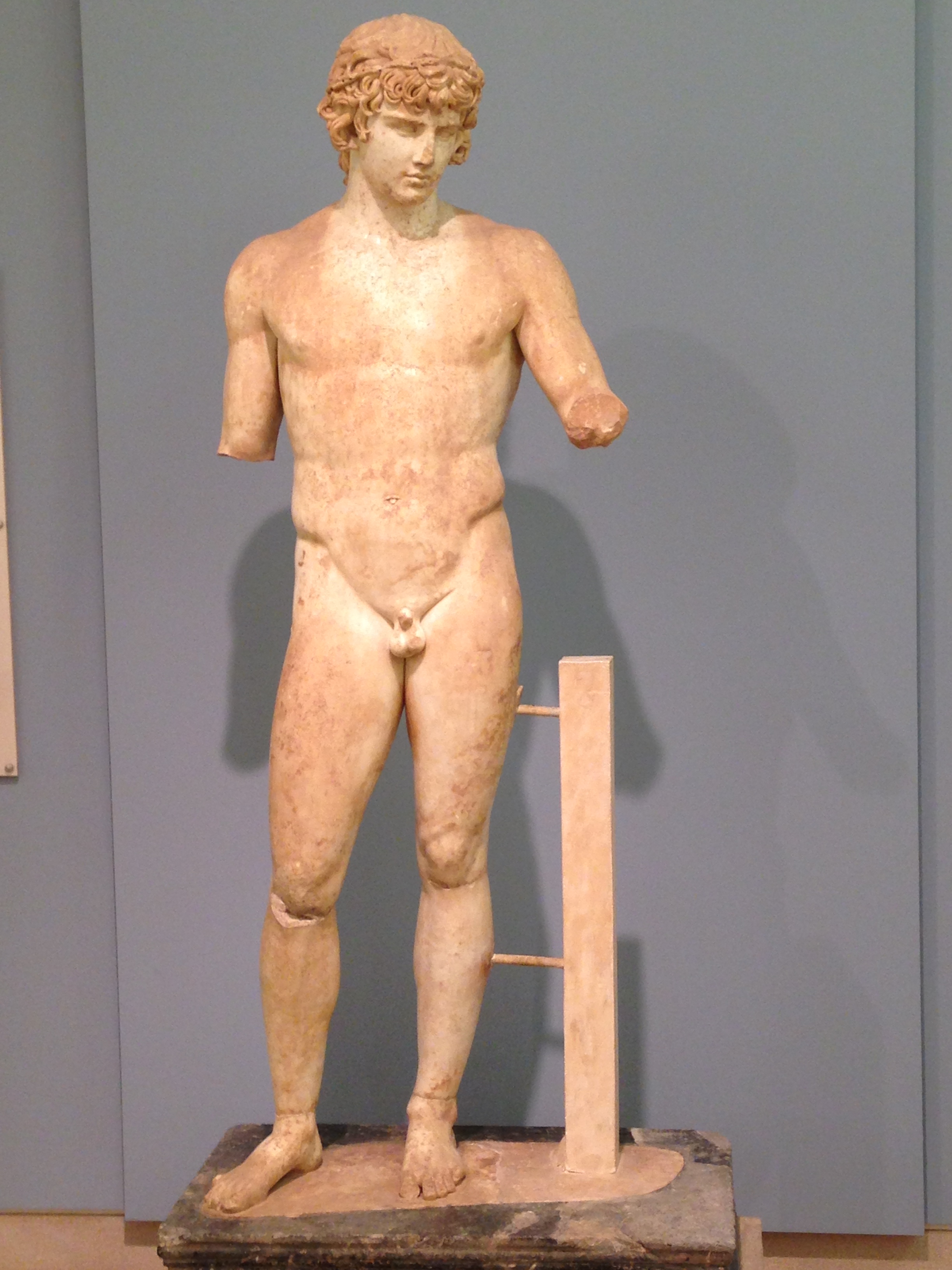
OSCAR WILDE TOURS is in the middle of our gay history and art tour of Italy, and one thing we’re exploring is the extraordinary relationship between Hadrian, Emperor of Rome (AD 117–138) and his kept boy Antinous. Like the ancient Greeks, the Romans considered adolescent boys a natural object of attraction for an adult man, and other emperors also had juvenile “favorites,” as did the Emperor Domitian with his lover Earinos, a eunuch who was praised by poets such as Martial and Statius. But Antinous seems to have been much more important in Hadrian’s life than a mere sex object.
We don’t know much about Antinous, when you get right down to it. He was from Bithynia, in modern Turkey, and become Hadrian’s lover in his teens. How they met is a mystery, though Hadrian did go through Antinous’ province a couple of times, so perhaps it was during one of those visits. The only thing we hear about their relationship (from an epic written in their praise) is a story about a lion hunt in which Antinous wounded the lion but failed to kill it, and Hadrian finished it off. Whether factual or legendary, it harks back to the kind of courage and mutual loyalty that the Greeks associated with their custom of “paiderastia.” In fact, it’s interesting that a Roman emperor would wish to be portrayed as so entirely Greek.
But the main thing we know about Antinous is that he died, at the age of nineteen, by falling into the Nile. Was he pushed? Was he sacrificed in some strange ritual? Feel free to speculate, as people in the ancient world (like the historian Cassius Dio) certainly did. In his interesting book on the topic, Royston Lambert suggests that Antinous—depressed by being “over the hill” (as nineteen was just past the acceptable age for this kind of relationship)— committed suicide. Also, since the Egyptians believed that human sacrifice could increase the volume of the Nile’s annual flood, it seems possible that he sacrificed himself to help Hadrian, whose status as a god was being called into question by a series of poor Nile floods.
Anyway, all that is speculation. The only certain thing is that when he died, Hadrian had Antinous declared a god. That might not sound surprising, but actually it was very unusual. Emperors sometimes were divinized, as were their wives. But this was the first and only time that an emperor’s boyfriend was deified. Hadrian founded a city dedicated to him on the Nile, and temples to him were erected throughout the empire. He was sometimes worshipped as a god, at times in conjunction with other gods (Osiris, Bacchus, et al.), and sometimes as a hero who interceded between you and the gods. In fact, amazingly (from a modern perspective), some ancient authors saw him as a competitor of Jesus.

The result is that Antinous is one of the individuals most frequently represented in Roman art (though not the most numerous, as some have claimed). There are statues of him all over the world now, in art museums such as the Metropolitan, the British Museum, and the Louvre. My favorite is in Delphi, a statue so beloved in ancient times that it still shines with the oils with which it was rubbed. But the greatest number of representations by far is in Italy. Many come from Hadrian’s villa in Tivoli, outside of Rome, where there was also a temple of Antinous, and there were many statues of him. Others come from private house shrines (like the one to the right).
You just keep running into him. There’s a bust of Antinous in the Uffizi and a gorgeous statue in the Naples Archaeological Museum. In Rome, he is everywhere: a statue (as Bacchus) and a bust at the Vatican, a bust in the Capitoline Museums, plus two busts and a plaque in the Palazzo Massimo ancient art museum. He also appears when you’re just walking around the city. The fake Egyptian obelisk on the Pincio, for instance, has prayers to Antinous on the sides; there’s a statue of him in the Banca d’Italia on the via Nazionale (dug up during construction of the building). One of the Hadrianic roundels that were re-used for the Arch of Constantine (next to the Colisseum) has a scene in which Hadrian and Antinous are hunting a boar.
So frequent have been our encounters with Antinous on this tour, I think we may start leaving prayer offerings when we see him. At least as portrayed, he is easy to worship: mysterious-looking with distant eyes, sensual lips, and hair that’s simultaneously tousled and perfect. If you’re going to turn a person into a god, you could do worse than the youthful Antinous.
Andrew Lear, the founder of Oscar Wilde Tours, is currently leading a tour of gay Italy. Tours in 2016 will include “Greece: The Homeland of Same-Sex Love” in May, “Gay London/Gay Paris” in September, and “Gay Italy” again in October.






Discussion3 Comments
Interesting article, that’s one way to immortalize your dead young lover – turn him into a god and make artwork out of him.
I thought he died by shoving a poisonous snake deeply and lovingly into his un-lubbed rectum and the whole “fell-into-the-Nile-and-drowned” story was to protect his reputation.
There is no clear explanation or testimony as to how Antinous died. A whole trove of Antinous-related material (much of it on his modern-day worship) can be found at http://www.antinopolis.org where a small cadre of dedicated Priests of Antinous maintains the Temple of Antinous website. He was a fairly impressive young man skilled in the use of weapons and hunting who so impressed the Imperial Court that he was generally accepted as the companion of the Emperor. It is doubtful whether people deriding Antinous would have survived the encounter, had they to meet and say the frivolous bullshit they did here to his face (hehehe).